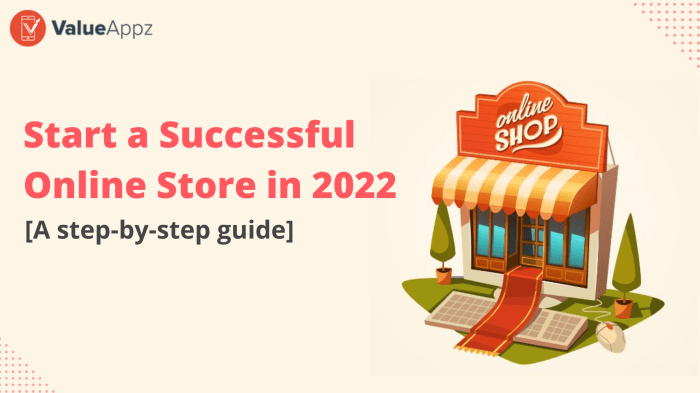Launching a thriving online store requires careful planning and execution. This guide provides a comprehensive, step-by-step approach to designing and building a successful e-commerce business. From defining your niche and crafting a business plan to building your website and implementing effective marketing strategies, we’ll cover all the essential aspects of creating a profitable online presence. We’ll explore various platforms, discuss crucial design elements for user experience, and delve into the intricacies of digital marketing to ensure your online store stands out and attracts customers.
This guide aims to equip you with the knowledge and strategies needed to navigate the complexities of the online retail landscape. Whether you’re a seasoned entrepreneur or just starting, this detailed roadmap will empower you to build a sustainable and successful online business.
Planning Your Online Store

Launching a successful online store requires meticulous planning. A well-defined strategy, from conceptualization to execution, is crucial for navigating the competitive e-commerce landscape and achieving sustainable growth. This section will guide you through the essential steps of planning your online store, from designing your sitemap to crafting a comprehensive business plan and identifying your niche.
Designing a Sitemap for an Online Bookstore
A clear sitemap is fundamental for user navigation and search engine optimization (). It provides a visual representation of your website’s structure, ensuring a logical and intuitive user experience. Below is a sample sitemap for a hypothetical online bookstore, utilizing a table format for clarity and responsiveness.
| Category | Subcategory | Subcategory | Subcategory |
|---|---|---|---|
| Fiction | Fantasy | Science Fiction | Historical Fiction |
| Non-Fiction | Biographies | Self-Help | History |
| Children’s Books | Picture Books | Chapter Books | Young Adult |
| Textbooks | Elementary | Middle School | High School |
| Cookbooks | Baking | International Cuisine | Vegetarian/Vegan |
| Mystery | Thriller | Crime | Detective |
| Romance | Contemporary | Historical | Paranormal |
| Science | Physics | Chemistry | Biology |
| Art & Photography | Painting | Sculpture | Photography |
| Bestsellers | Fiction | Non-Fiction | Children’s Books |
Business Plan for a Handmade Jewelry Online Store
A robust business plan is essential for securing funding, guiding operations, and measuring success. This plan Artikels the key components for a new online store selling handmade jewelry.
Market Analysis:
The handmade jewelry market is experiencing significant growth, driven by increasing demand for unique and personalized items. Competition exists, but a focus on a specific style or material can create a distinct market position. Analysis of competitor pricing and marketing strategies is crucial.
Target Audience:
The target audience could be women aged 25-55, interested in fashion and unique accessories, with a disposable income to spend on higher-quality, handcrafted jewelry. Further segmentation could be based on lifestyle, interests, and purchasing behavior.
Pricing Strategy:
Pricing will consider material costs, labor, and desired profit margin. A premium pricing strategy might be adopted to reflect the handcrafted nature and exclusivity of the products. Promotional discounts and bundles could be used strategically.
Marketing Plan:
Marketing efforts will focus on building a strong brand presence through social media platforms like Instagram and Pinterest, showcasing high-quality product photography. Collaborations with influencers and participation in online craft markets will also be explored. Paid advertising on social media and search engines may be implemented as the business grows.
The Importance of Choosing a Niche for an Online Store
Focusing on a specific niche allows for targeted marketing, reduced competition, and the development of a strong brand identity. A niche provides a clear value proposition and helps to attract a loyal customer base.
Examples of Successful Niche Online Stores:
- Etsy: While not a single store, Etsy is a platform that showcases the power of niche markets. It allows artisans and crafters to sell handmade and vintage goods, showcasing a vast array of niche products, from handcrafted soaps to unique clothing items. Its unique selling proposition (USP) is its curated selection of unique and often personalized items not readily available in mass-market retailers.
- Uncommon Goods: This online retailer focuses on unique and quirky gifts, catering to customers seeking unusual and memorable presents. Their USP is their carefully curated selection of innovative and often humorous products, differentiating them from typical gift shops.
- Threadless: Threadless is an online marketplace for independent artists selling t-shirts and other apparel. Their USP is the community-driven design aspect, allowing customers to vote on designs and participate in the creative process. This fosters a strong sense of community and provides a unique selection of apparel not found elsewhere.
Building Your Online Store

Building your online store involves choosing the right platform, designing a seamless checkout process, and integrating a secure payment gateway. These crucial steps directly impact your store’s success, influencing user experience, sales conversion rates, and overall security. Careful consideration at each stage is essential for a thriving e-commerce business.
E-commerce Platform Comparison: Shopify, WooCommerce, and Wix
Selecting the right platform is the foundation of your online store. Each platform offers unique strengths and weaknesses. The optimal choice depends on your technical skills, budget, and specific business needs. The following table summarizes the key differences between Shopify, WooCommerce, and Wix:
| Feature | Shopify | WooCommerce | Wix |
|---|---|---|---|
| Ease of Use | Very easy; user-friendly interface, minimal technical expertise required. | Moderate; requires some technical knowledge, especially for customization. | Easy; intuitive drag-and-drop interface, suitable for beginners. |
| Cost | Subscription-based; various pricing plans with varying features. | Open-source; free to use, but hosting and themes cost extra. | Subscription-based; pricing plans with varying features. |
| Customization | Limited; customization options are primarily through themes and apps. | Highly customizable; extensive options for design and functionality through plugins and themes. | Moderate; customization is primarily through the platform’s built-in tools. |
| Scalability | Highly scalable; easily handles increasing traffic and sales. | Highly scalable; can be adapted to handle significant growth with proper hosting. | Moderate scalability; may require upgrading to higher-tier plans as your store grows. |
| Good capabilities; built-in tools and app integrations. | Good capabilities; requires plugin integration for optimal performance. | Good capabilities; built-in tools for optimization. |
Designing a User-Friendly Checkout Process for an Online Clothing Store
A streamlined checkout process is crucial for minimizing cart abandonment. A complex or lengthy process can deter customers from completing their purchases. The following steps Artikel an optimal checkout flow for an online clothing store:
- Review Cart: A clear summary of items, quantities, sizes, and total cost, including taxes and shipping.
- Guest Checkout or Login: Offer both options for convenience. Make the guest checkout process simple and quick.
- Shipping Information: Use auto-fill functionality where possible and clearly display shipping costs upfront. Offer multiple shipping options with estimated delivery times.
- Billing Information: Allow customers to use a saved address if they have an account. Clearly display the billing address for verification.
- Payment Method Selection: Offer a variety of secure payment options (credit cards, PayPal, Apple Pay, etc.).
- Order Review and Confirmation: Display a final summary of the order before submitting the purchase. Provide a clear confirmation message after successful payment.
- Order Tracking: Provide an order tracking number and link to monitor shipment progress.
Selecting and Integrating a Secure Payment Gateway for Digital Products
For online stores selling digital products, choosing a secure payment gateway is paramount. The gateway must handle sensitive financial information securely and offer features suitable for digital product delivery. Several factors should be considered:
Factors such as transaction fees, security features (PCI compliance), integration ease with the e-commerce platform, supported payment methods, customer support, and reporting capabilities are all critical. For example, Stripe and PayPal are popular choices known for their robust security and user-friendly interfaces. Consider the specific needs of your business and compare different gateways before making a decision. Ensure the chosen gateway seamlessly integrates with your e-commerce platform to automate order processing and digital product delivery.
Marketing and Growth

Successfully launching an online store requires more than just a well-designed website and a robust inventory. A comprehensive marketing and growth strategy is crucial for attracting customers, building brand awareness, and driving sales. This section will explore key marketing strategies to propel your online store’s success.
Effective marketing leverages various channels to reach your target audience and convert them into loyal customers. A multi-faceted approach, incorporating social media, email marketing, and search engine optimization (), is typically the most effective.
Social Media Marketing Strategy for Organic Food Products
A strong social media presence is essential for connecting with health-conscious consumers interested in organic food. Platforms like Instagram, Facebook, and Pinterest are particularly well-suited for visually appealing food products.
For example, an Instagram strategy could focus on high-quality images and videos showcasing the freshness and quality of the products. Stories could feature behind-the-scenes glimpses of the farming process or recipes using the products. Facebook could be used for longer-form content, such as blog posts about the benefits of organic food or customer testimonials. Pinterest offers a platform for visually driven content, ideal for creating boards showcasing recipes and product pairings.
Email Marketing Campaign for a New Electronics Product Launch
Email marketing remains a powerful tool for reaching potential customers directly. A well-crafted email campaign can generate excitement and drive sales for a new product launch.
Consider an email campaign for a new smartwatch. The subject line could be something attention-grabbing, like “Introducing the Future of Fitness: [Smartwatch Name]”. The email body should highlight the key features and benefits of the smartwatch, using compelling visuals and concise language. A strong call to action, such as “Shop Now and Get 10% Off,” encourages immediate purchase. A series of emails could be used to build anticipation before the launch, then follow up after the launch with reminders and special offers.
Search Engine Optimization () for Online Stores
is crucial for improving your online store’s visibility in search engine results pages (SERPs). Higher rankings mean more organic traffic to your website, leading to increased sales. involves both on-page and off-page optimization techniques.
Effective requires a strategic approach that addresses both on-page and off-page factors. On-page optimization focuses on elements within your website, while off-page optimization focuses on external factors influencing your search ranking.
- On-Page Optimization Techniques:
- research and implementation in product descriptions, titles, and meta descriptions.
- Optimized website structure and navigation for improved user experience.
- High-quality product images with descriptive alt text.
- Fast loading speed and mobile responsiveness.
- Creation of engaging and informative product descriptions.
- Off-Page Optimization Techniques:
- Building high-quality backlinks from reputable websites.
- Creating and sharing valuable content (blog posts, articles) related to your products.
- Engaging in social media marketing to increase brand awareness and drive traffic.
- Local optimization for businesses with physical locations.
- Monitoring and managing online reputation through reviews and feedback.
Wrap-Up

Building a successful online store is a journey, not a destination. This guide has provided a foundational framework, outlining the key steps involved in creating a thriving e-commerce business. By carefully planning your store, selecting the right platform, designing a user-friendly experience, and implementing effective marketing strategies, you can significantly increase your chances of success. Remember to consistently adapt and refine your approach based on data and customer feedback to ensure your online store continues to grow and prosper in the ever-evolving digital marketplace.